Sushi Kaneyoshi (Los Angeles, CA) [2]
Kaneyoshi × Inaba Collaboration
250 1st St, Los Angeles, CA 90012
213-277-2388
kaneyoshi.us
Tue 05/20/2025, 07:00p-10:25p
If I'm thinking about the top sushi-ya in Southern California, two of the names that come to mind are Yasuhiro Hirano's (平野泰洋) Sushi Inaba (鮨稲葉) in Torrance and Yoshiyuki Inoue's (井上嘉之) Sushi Kaneyoshi (鮨かね嘉) in Downtown. The two shokunin have actually know each other for quite a while, and first started working together in April 2020, crafting bara-chirashi boxes during the early days of the pandemic. The partnership lasted until the opening of Kaneyoshi for takeout in August that year, while on-site dining started there the following April. Although both Chefs were now running their restaurants full-time, they still wanted to be able to cook together, and thus this series of collaborative omakase dinners was instituted--Tuesdays at 7:00pm at Kaneyoshi, for up to a dozen diners each time, at a charge of $400 a head.
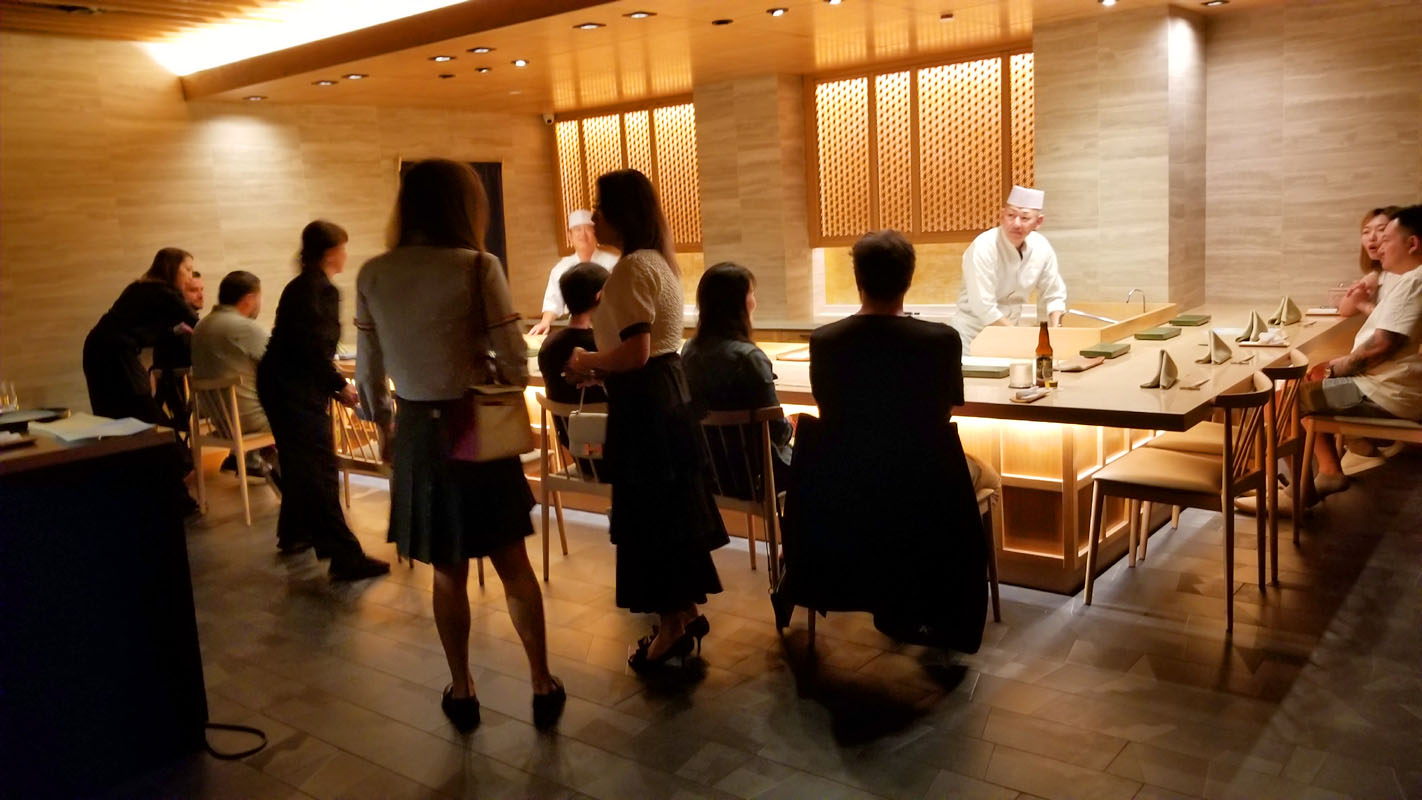
Decor-wise, things really haven't changed much at all since the subterranean restaurant opened (it's located in the basement of Little Tokyo's Kajima Building).

Here we see the view from my seat, the fifth position from the left.

Shown above is Sushi Kaneyoshi's sake list and selection of wines and other sundry beverages. If you'd like to bring your own booze, the corkage fee is $100 per bottle. Click for a larger version.
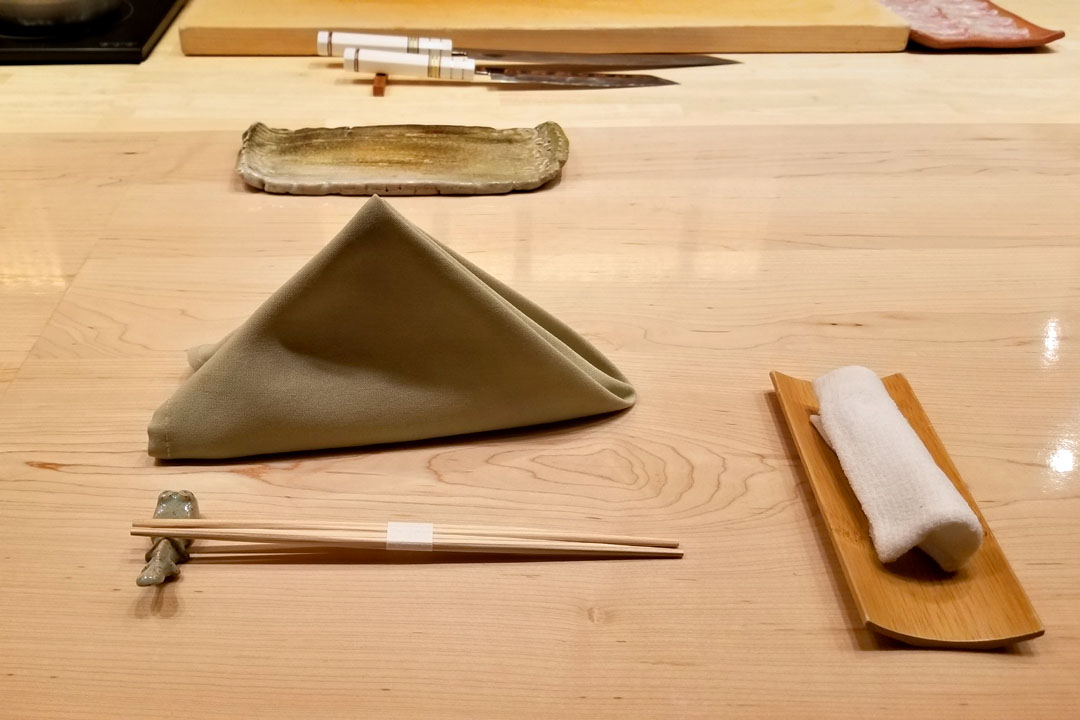
A straightforward place setting. Note that the oshibori was chilled (apropos given the hot weather), and was replaced ahead of the nigiri section of our dinner.

Chef Inoue and assistant Anton plating our first course.
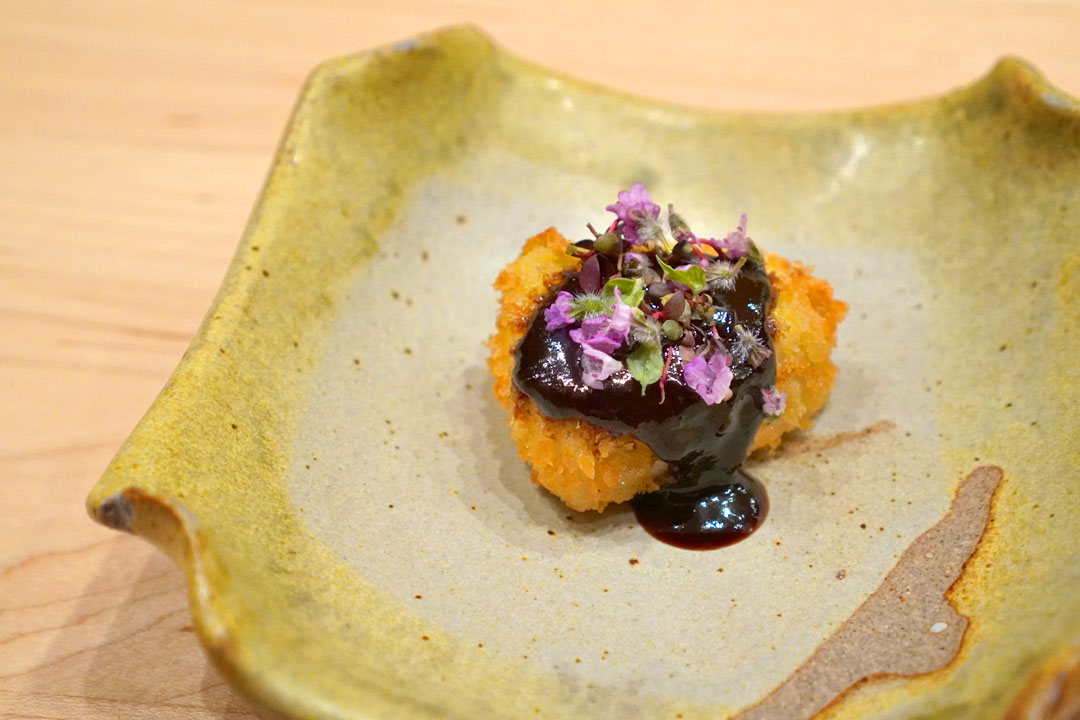
1: Sawara Furai
The collab commenced with delicately-fried, panko-coated Japanese king mackerel, topped with a heady miso-based sauce teeming with familiar, savory-sweet flavors. I quite liked the brightness imparted by the shiso blossoms as well.
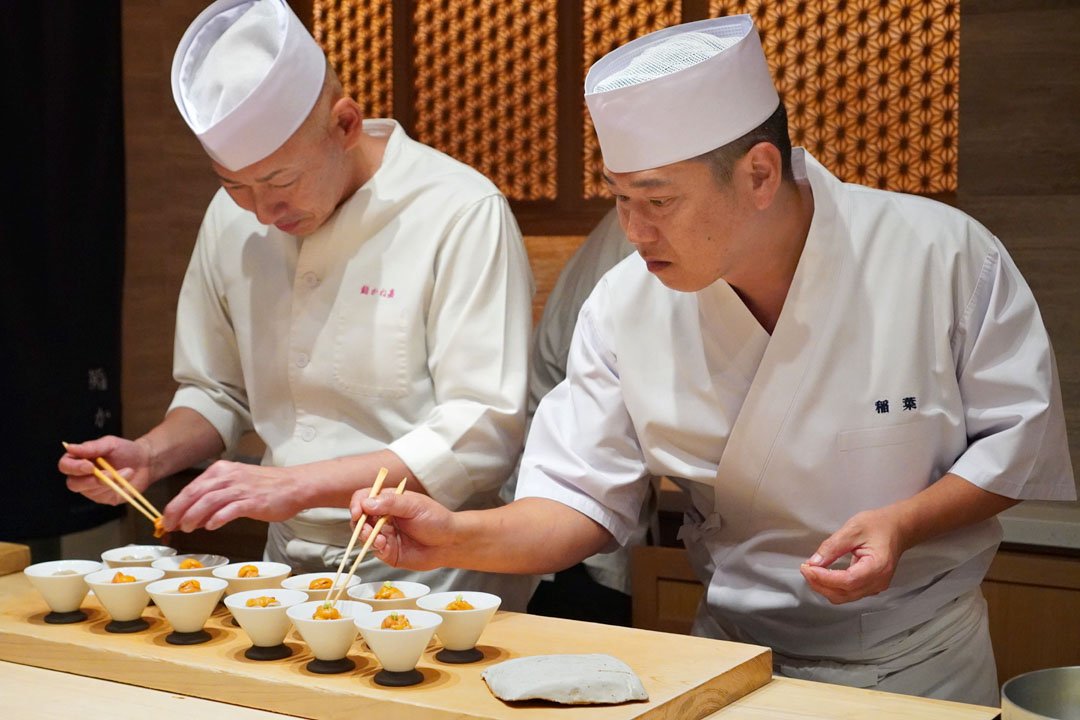
Inoue-san (left) and Hirano-san (right) preparing our next course.
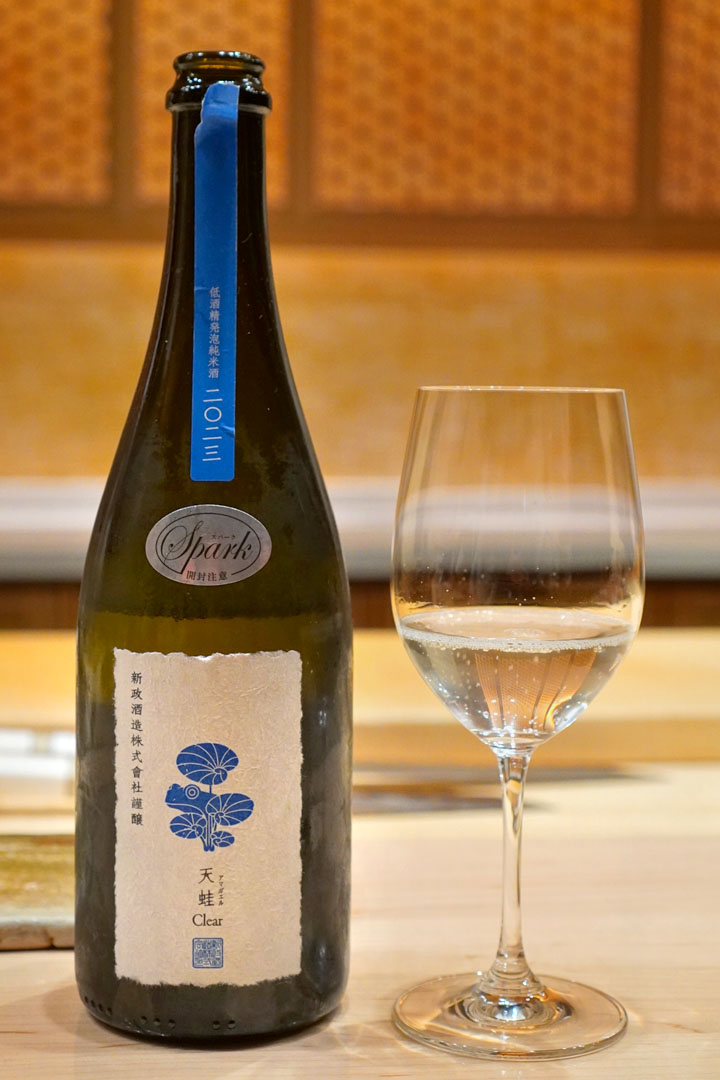
We opted for sparkling junmai-shu (純米酒 発泡性) tonight and BYOB'd three bottles, starting with the 2023 Aramasa Private Lab Amagaeru Clear (新政 プライベートラボ 天蛙 クリア), a low-alcohol, pasteurized, secondary-fermented, 60% seimai-buai nihonshu crafted from Akita Prefecture rice. Released this year, the "tree frog" sake possessed aromas of sweet pâtisserie and tropical-leaning fruit, with a hint of heat underneath. On the palate, this demonstrated a light effervescence and elegant acidity, with familiar notes of lush orchard fruits rendered in a dry-ish manner. This was a great way to start, and just a lovely tipple in general.

2: Uni Soba
Chef Hirano regularly serves soba over at Sushi I-naba, so it was no surprise to see the dish featured tonight. The buckwheat noodles were great texturally, with a lovely chew, while their nuttiness made a lot of sense with all the savory, smoky, and sweetly saline flavors happening here. Nice zestiness from the hanaho, too.
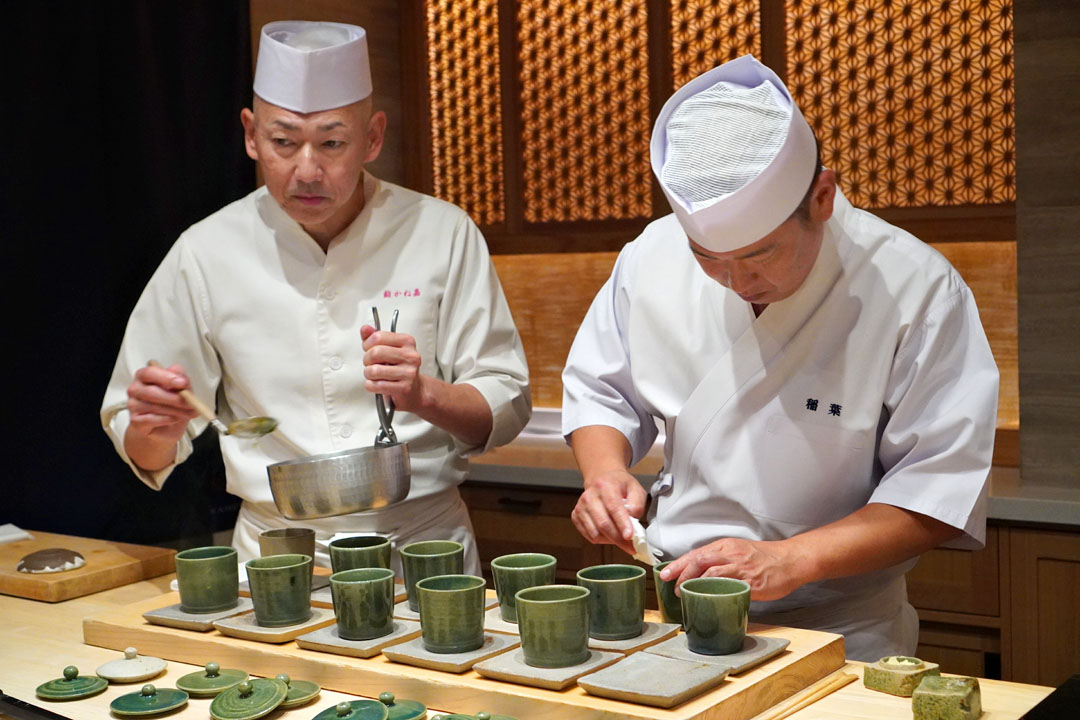
Yoshiyuki-san and Yasuhiro-san readying our chawanmushi course.

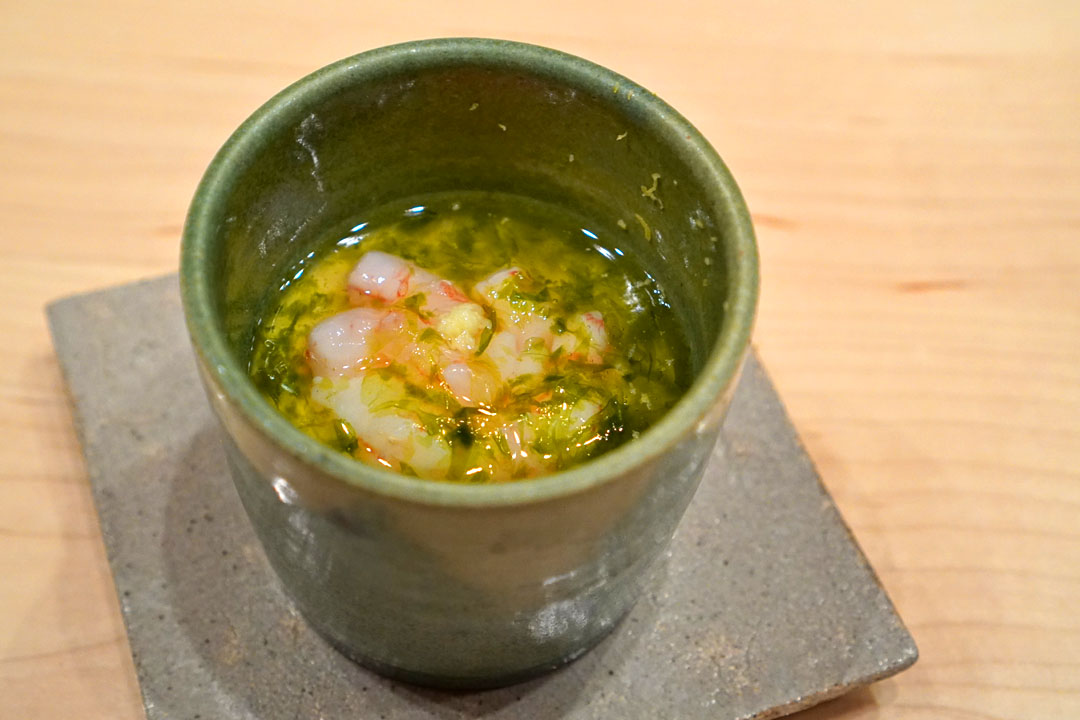
3: Chawanmushi
The chawanmushi was unlike most I've had. What really struck me was the seaweed, which had this unabashedly grassy character that linked up quite well with the brininess of the shrimp. And at the same time, the egg custard itself was perked up by the sourness of what I believe was yuzu, all making for a more refreshing dish than I'm accustomed to.

4a: Kue Sashimi
Longtooth grouper is a relatively uncommon sight around these parts, so it was nice to see it on the menu. The kue showed off a satisfying, slightly chewy texture, while its clean, lean taste was beautifully complemented by a dab of salt, which seemed to really emphasize the fish's sweetness.
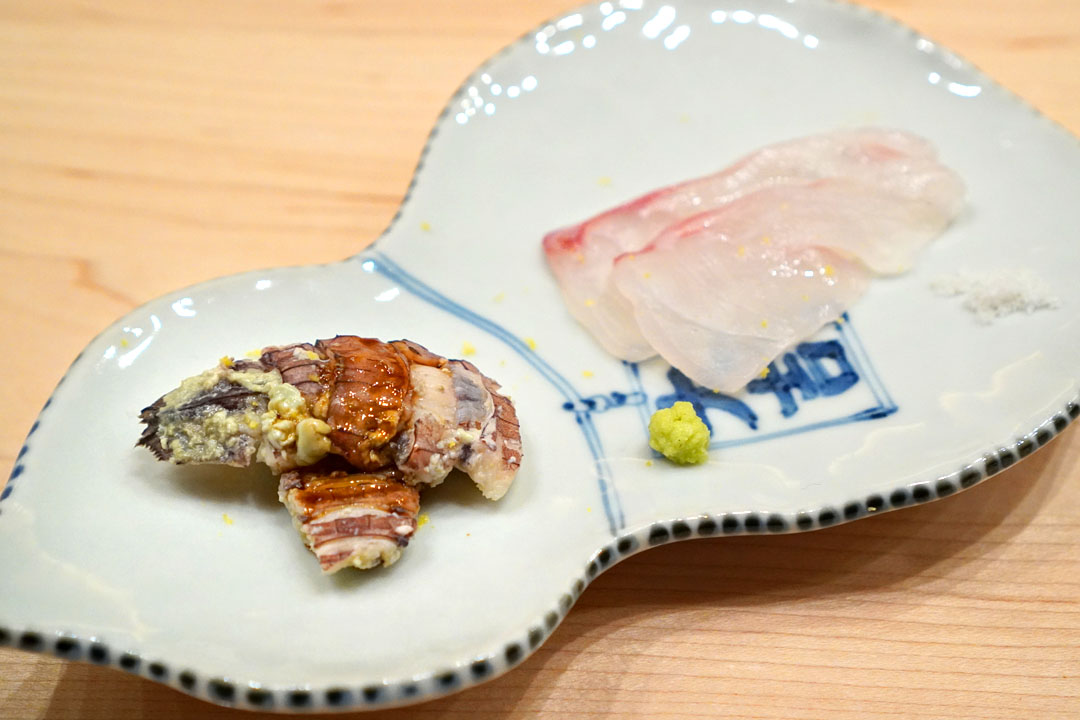
4b: Shako
Japanese mantis shrimp is another atypical item at local sushi restaurants, so once again, I was glad to enjoy it tonight, especially since we were right in the middle of the season. The shrimp had that almost "spongey" consistency I was expecting, while its savory, saline qualities were countered by both a layer of sweetness and the heat of wasabi.

Chef Yoshiyuki slicing cuts of bonito for the following course.

5: Katsuo Tataki
Seared skipjack tuna showcased a delectable, lingering smoke that married swimmingly with the roasty qualities of nori. Simultaneously, an egg-boosted soy sauce actually served to moderate the strong flavors at play.
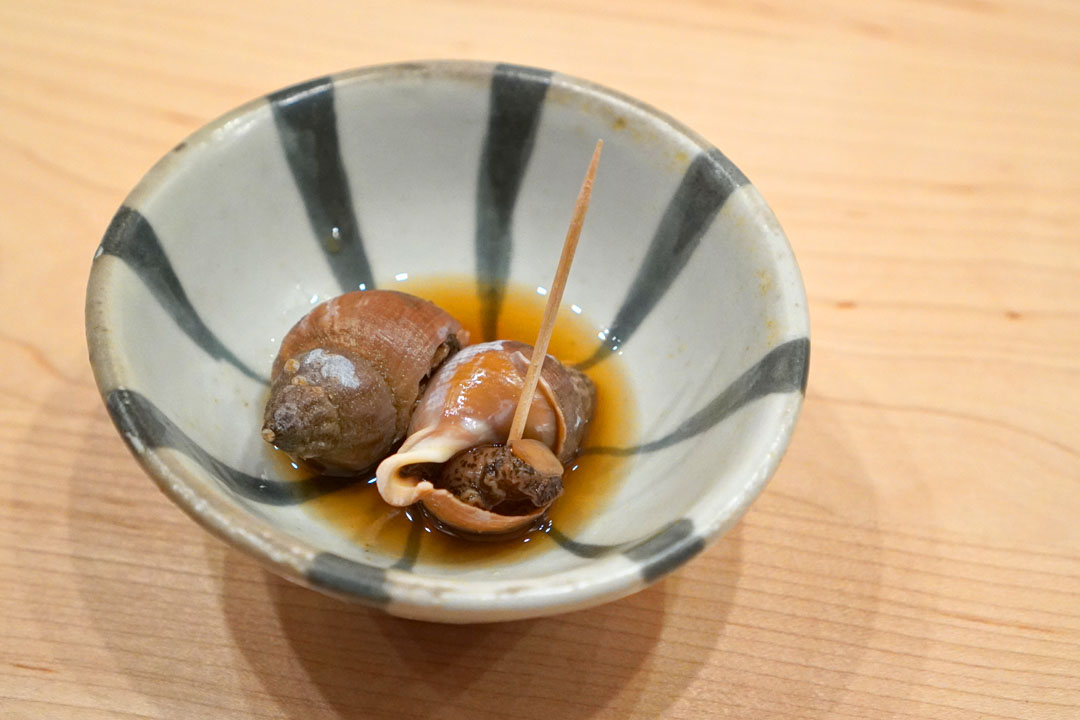
6: Tsubugai
Whelk was a bit of an unexpected sight, but not an unwelcomed one. The sea snail had that chewy, almost "crunchy" texture I was looking for, while flavors were a familiar mix of savory and sweet.
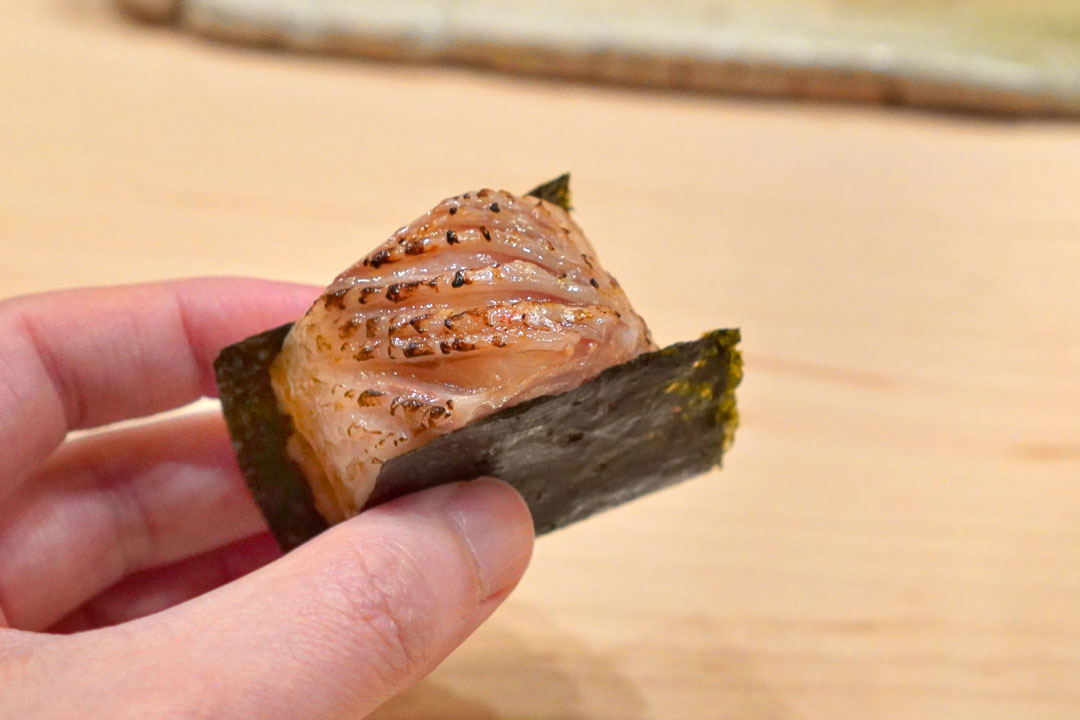
7: Nodoguro
Given that it's a perennial favorite of mine, I was happy to find blackthroat seaperch on the menu this evening. I was certainly a fan of the fish's soft, fatty, flavorful flesh, tinged with a hint of char, as well as the grassy, oceany contribution from the seaweed on the back end. However, what surprised me was the akamutsu's "freshness" compared to most preparations I've had.

8: Hotaru Ika
Oil-marinated firefly squid conveyed a long-lingering brininess that was perfectly offset by the familiar zing of chopped onion and the prickliness of Japanese pepper.

Our second BYO selection was the 2023 Aramasa Private Lab Amagaeru Clear Dry (新政 プライベートラボ 天蛙 クリア ドライ), another low-alcohol sparkler made from Akita Sake Komachi (秋田酒こまち) rice and Kyokai No. 6 (きょうかい6号) yeast. This "celestial frog" was actually the companion bottle to the one above, and was designed to be markedly drier, I'm assuming the result of an extended fermentation process. The nose was less generous, though it still offered up that pastry-like sweetness, and this time with much clearer melon-like nuances. Taking a sip, I found this significantly fizzier, with much bigger bubbles that definitely perked up the palate in a crisp, sharp, almost brazen manner. This was also considerably drier, as its name would suggest, but there was still a backbone of fruitiness that kept things in balance. Overall, it was great to be able to compare these two sister sakes back-to-back.

9: Ankimo
A shard of monkfish liver had it savory, sweet, saline qualities well-accented by the sting of wasabi.
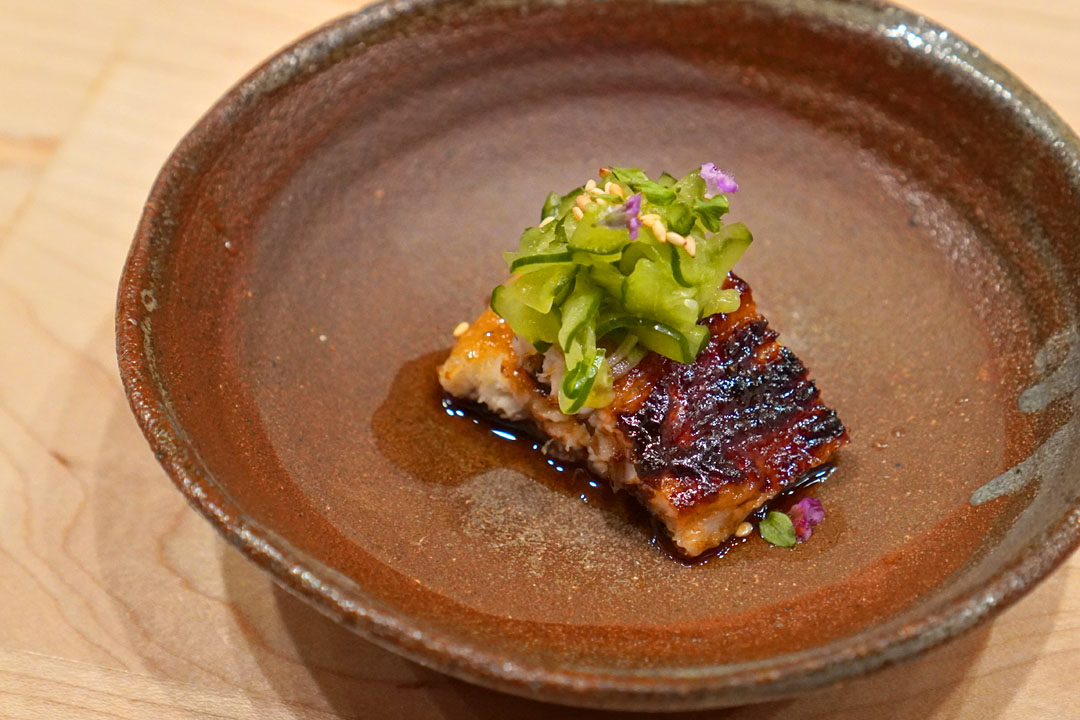
10: Uzaku
Grilled freshwater eel display an agreeable char along with an abundance of dark, savory flavors, all evened out by both cucumber and a vinegar dressing.

We knew that the sushi portion of our meal was about to begin once the ginger (a saltier than usual preparation) appeared.
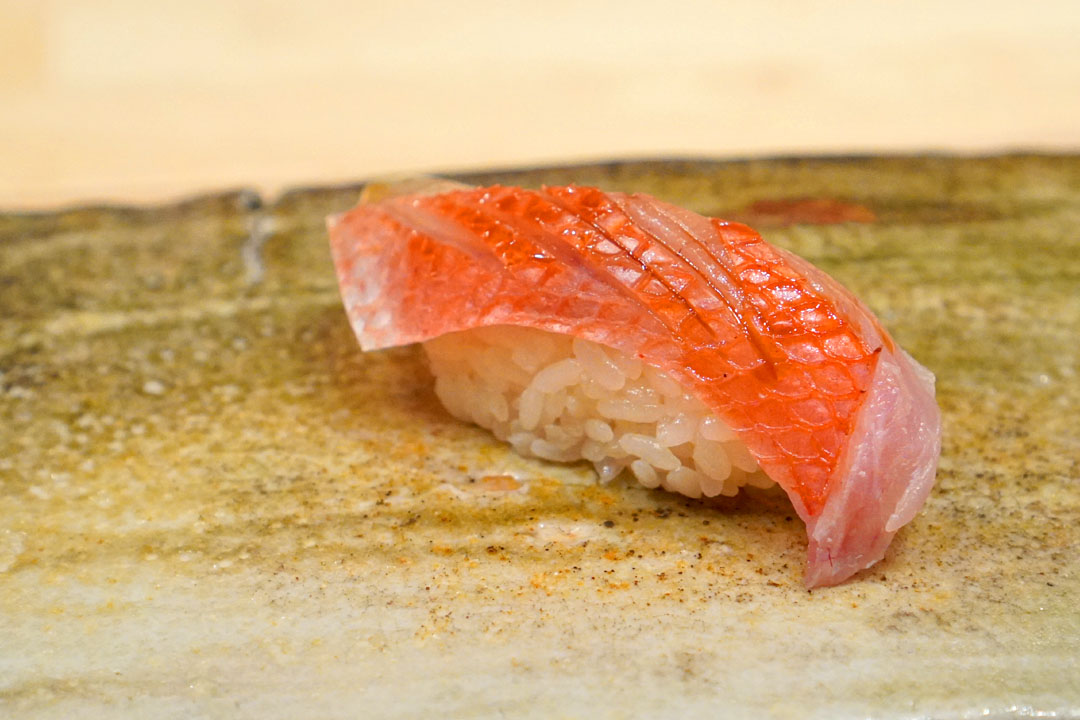
11: Kinmedai
Golden eye snapper is one of my preferred neta, so it was nice to kick things off with it. The fish had the supple mouthfeel I was hoping for, while its sweetness was set off by the noticeable warmth of the shari.
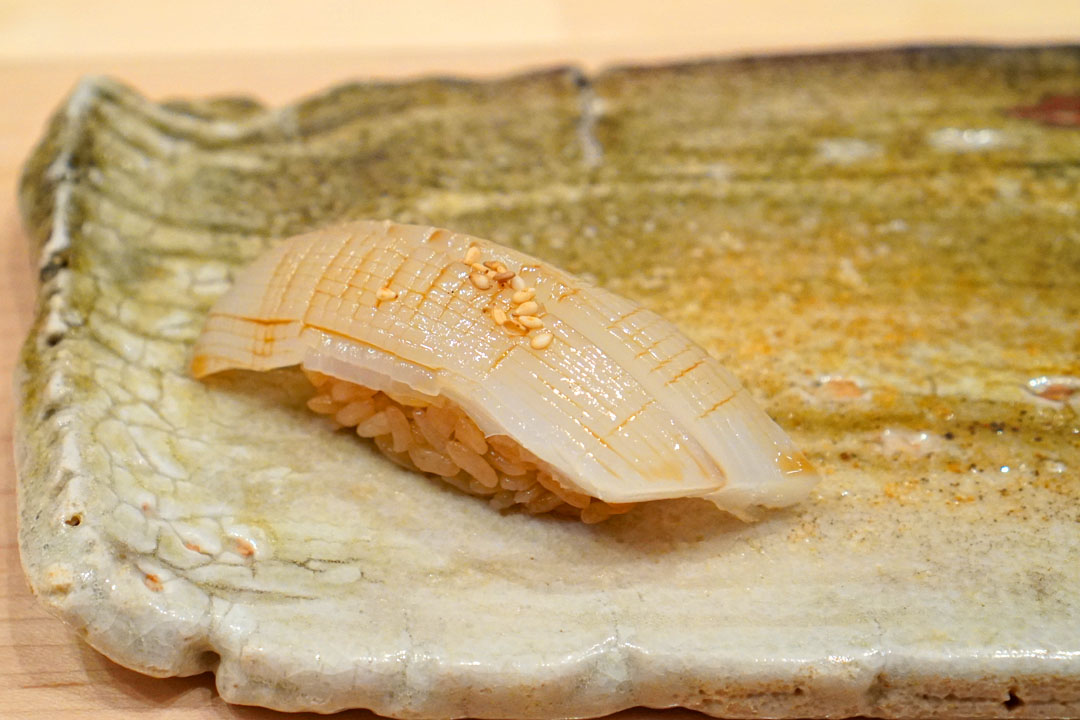
12: Aori Ika
A well-scored cut of bigfin reef squid arrived soft and sticky, while its gently sweet taste went hand-in-hand with both the aggressively tangy rice and the nuttiness of that sesame seed topping.
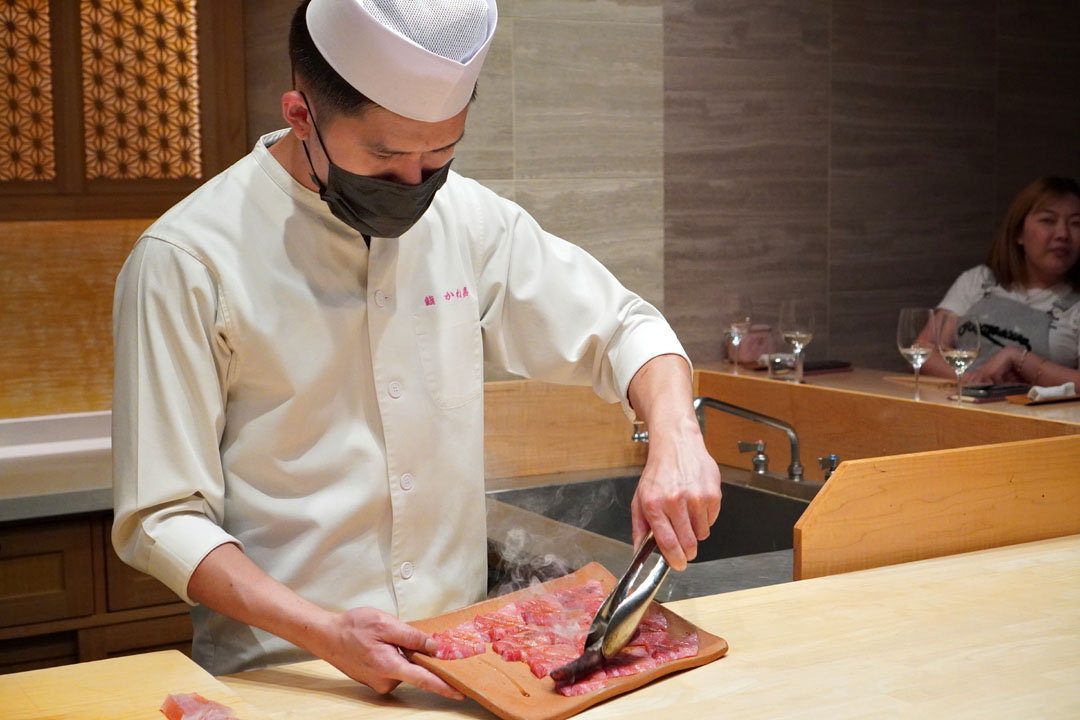
Anton-san searing toro using Japanese charcoal.
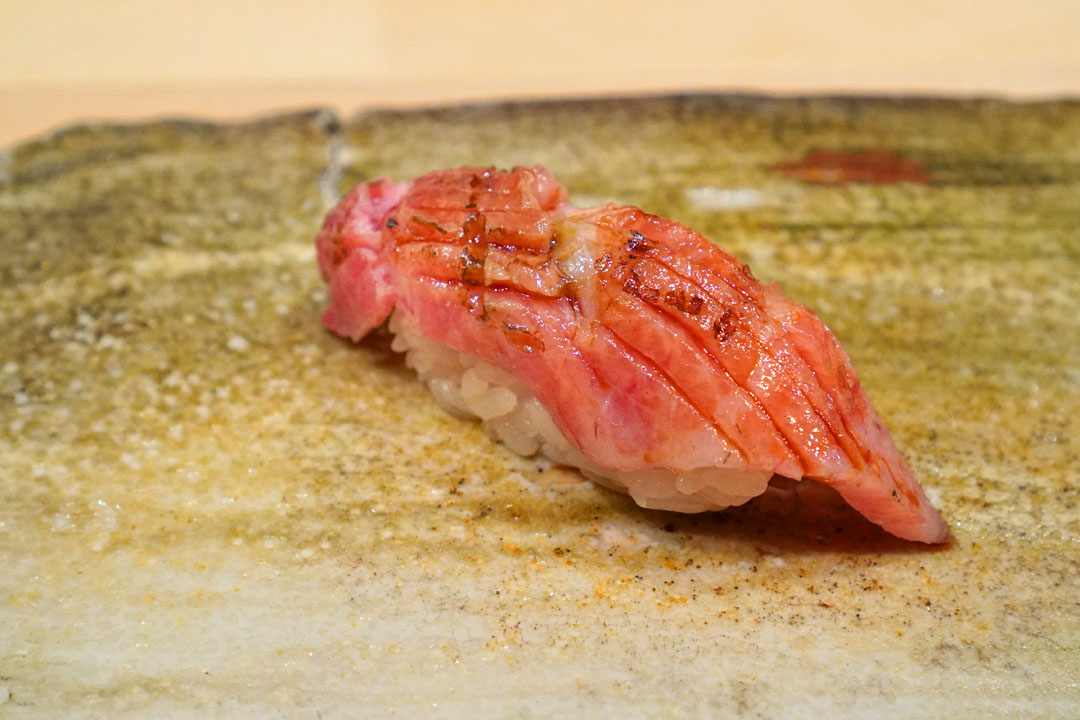
13: Toro
Not surprisingly, the tuna belly was the most in-my-face nigiri of the night, its plethora of rich, fatty, smoky, umami-laden flavors duly tempered by that mild sumeshi.
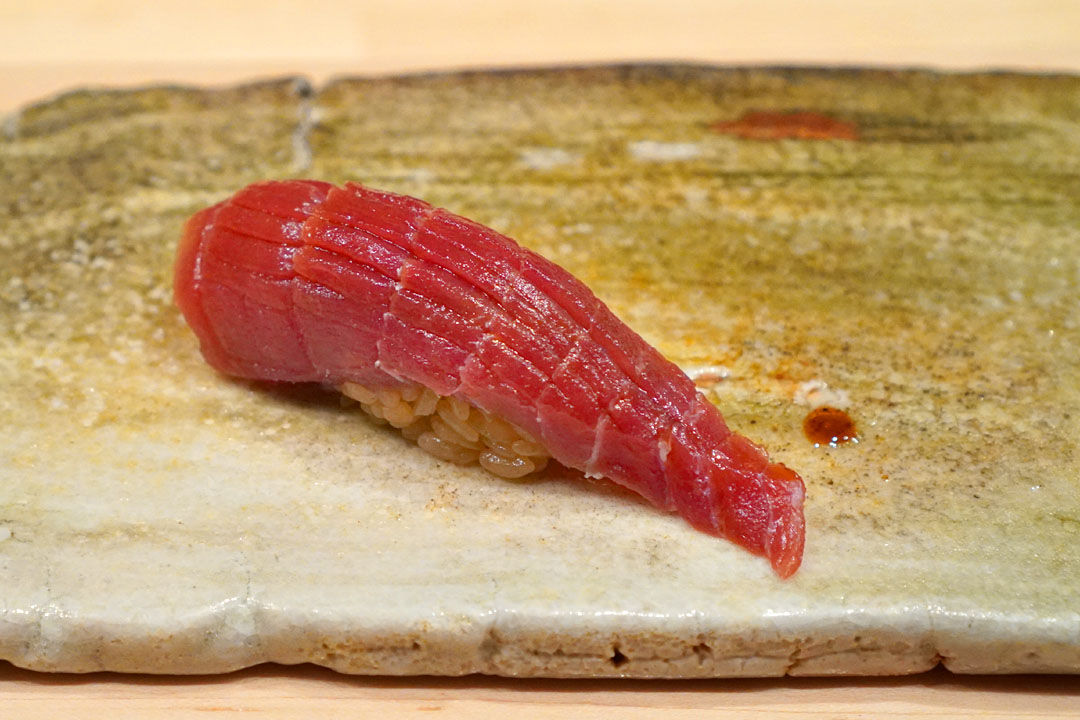
14: Akami Zuke
Marinated tuna was smooth and silky in the mouth, the fish melding seamlessly with both soy and wasabi, all while that vinegar-forward rice kept things in check.
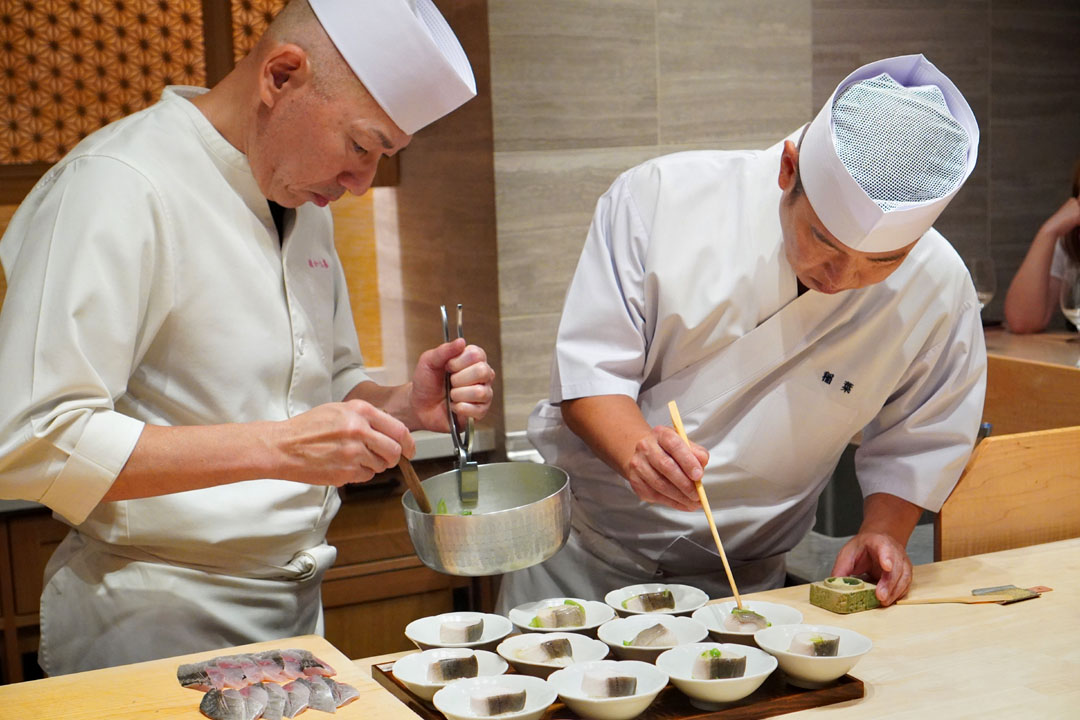
Yoshi-san and Yasu-san are shown assembling mushi zushi.
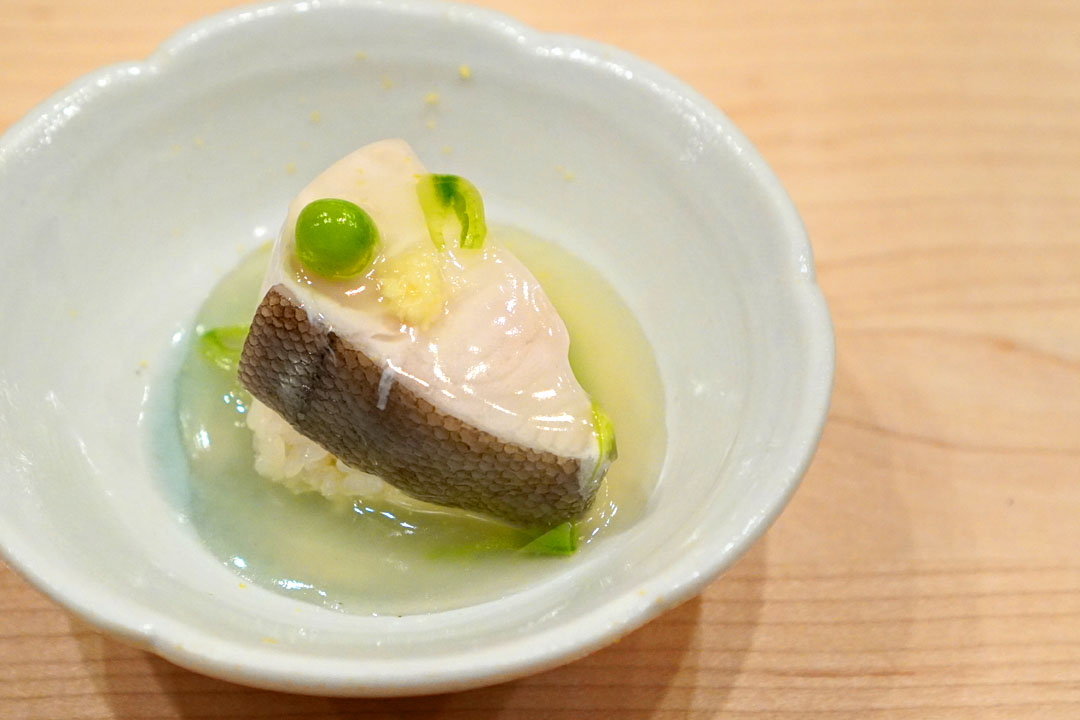
15: Gindara Mushi Sushi
A preparation of mushizushi (steamed sushi) featuring black cod was a first for me. I found the sablefish tender and flaky, its subdued salinity brightened up by pea and ginger while a thick sauce (ankake perhaps?) helped bind everything together.

The evening's final libation was the Aramasa Next Five The Final 2024, a 40% seimai-buai, kimoto-style, wood-aged sparkling junmai-daiginjo made with 100% Misato Nishiki (美郷錦) rice harvested in Akita Prefecture in 2022. Interestingly, this was actually a collaborative effort from five Akita-area sake brands: Aramasa (新政), Harukasumi (春霞), Ippakusuisei (一白水成), Yamamoto (山本), and Yukinobijin (ゆきの美人). The NEXT5 unit was formed back in 2010, and this was apparently their final creation together, bottled back in February last year. In any case, the bouquet here was fresh and invigorating, with a pastry dough-esque sweetness backed by a pert minerality that I didn't get in either of the preceding bottles. Palate-wise, this was pleasingly pétillant, with a thicker, richer mouthfeel and plenty of fruity, almost tropical flavors, all tinged with a bit of lactic goodness. Just delightful.
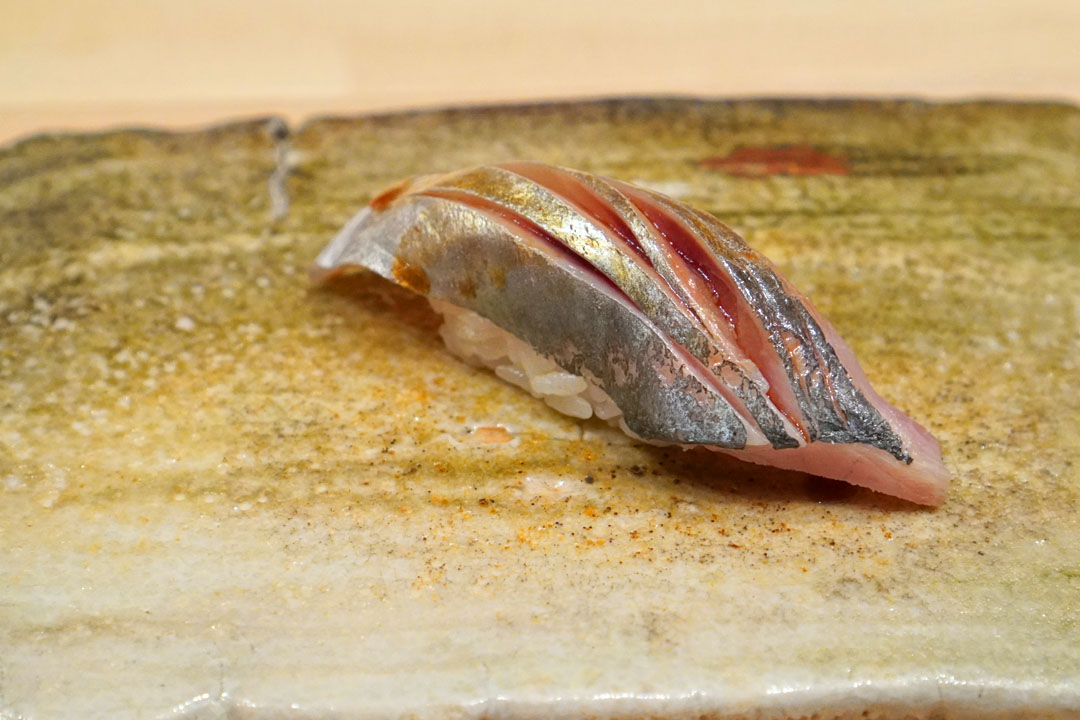
16: Aji
I always look forward to horse mackerel, and it was spot-on tonight. The fish highlighted a robust-yet-refined brininess that meshed like clockwork with both ginger and the countering qualities of the rice.
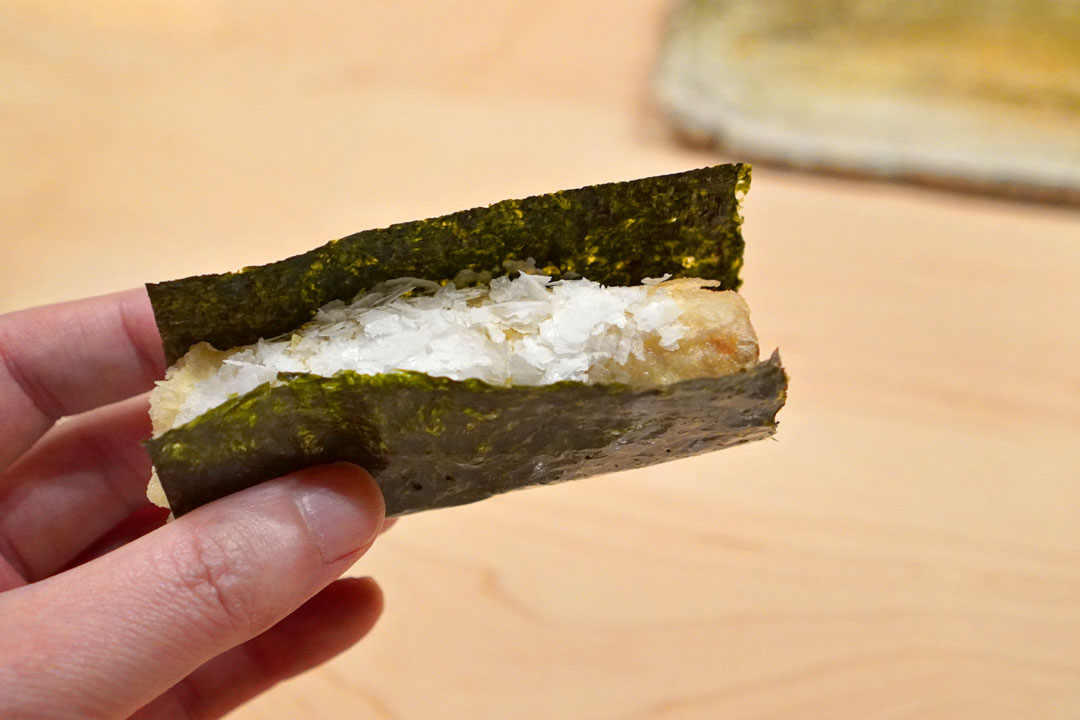
17: Mehikari Tempura
Mehikari (round greeneyes) is another ingredient I don't encounter too often, which is shame given how delicious it was. The fish had a pretty remarkable sweetness that combined perfectly with that flaked salt, all while both the tart rice and toasty seaweed completed the experience. A surprise standout for me.

18: Kohada
The gizzard shad was also a winner thanks to its gratifyingly meaty texture, healthy dosing of sweetness, and sophisticated salinity. Once again, the rice was crucial here for balance.
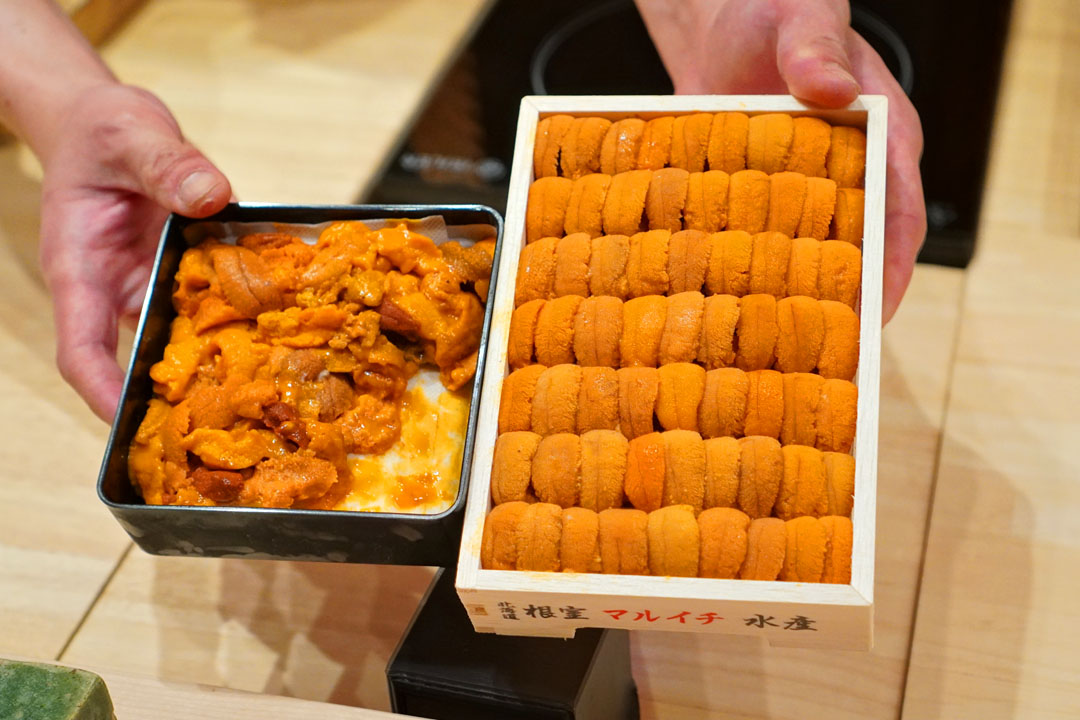
Chef Yasuhiro was using two brands of uni tonight: Sapporo Kaneshin Suisan (札幌 カネシン 水産) and Hokkaido Nemuro Maruichi Suisan (北海道 根室 マルイチ 水産).
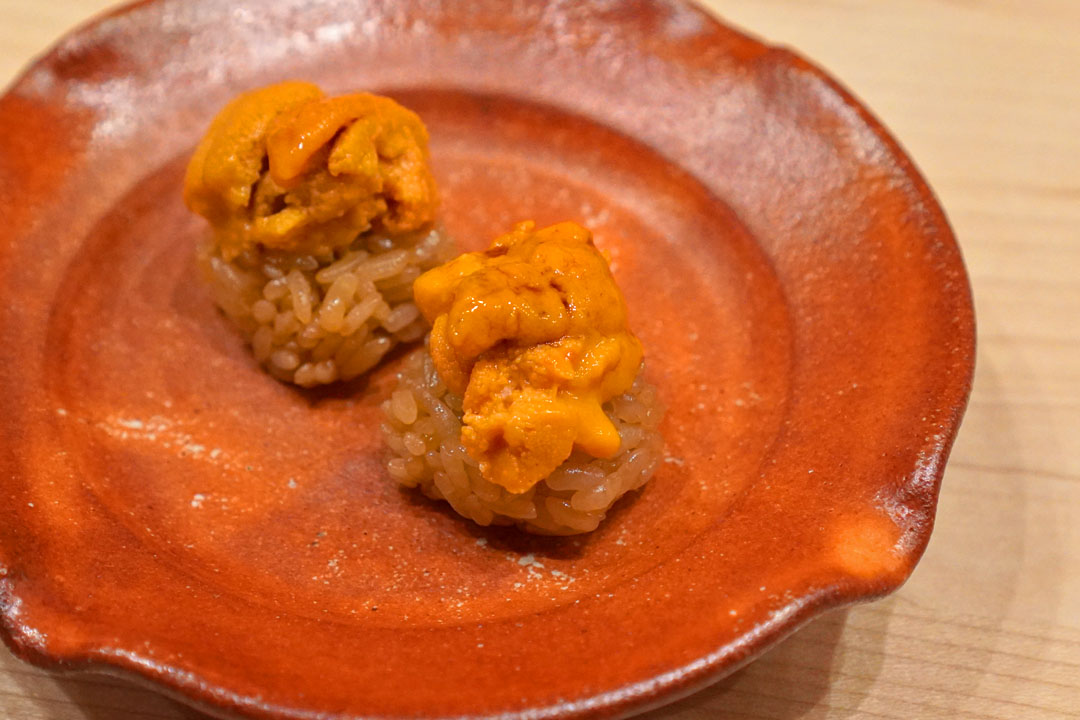
19: Bafun Uni
The sea urchin above was served two ways. I started with the presentation on the right, which was composed of both female and male roe. It had all the cool, sweet-n-saline qualities I anticipated, and combined impeccably with the Chef's warm, piquant rice. On the left were exclusively male gonads, which I'd say were more umami-forward, with this nuttiness that really came through.

20: Anago
Saltwater eel ate soft and sweet, its pinpricks of salinity regulated by that sticky-ish, gently-seasoned rice.
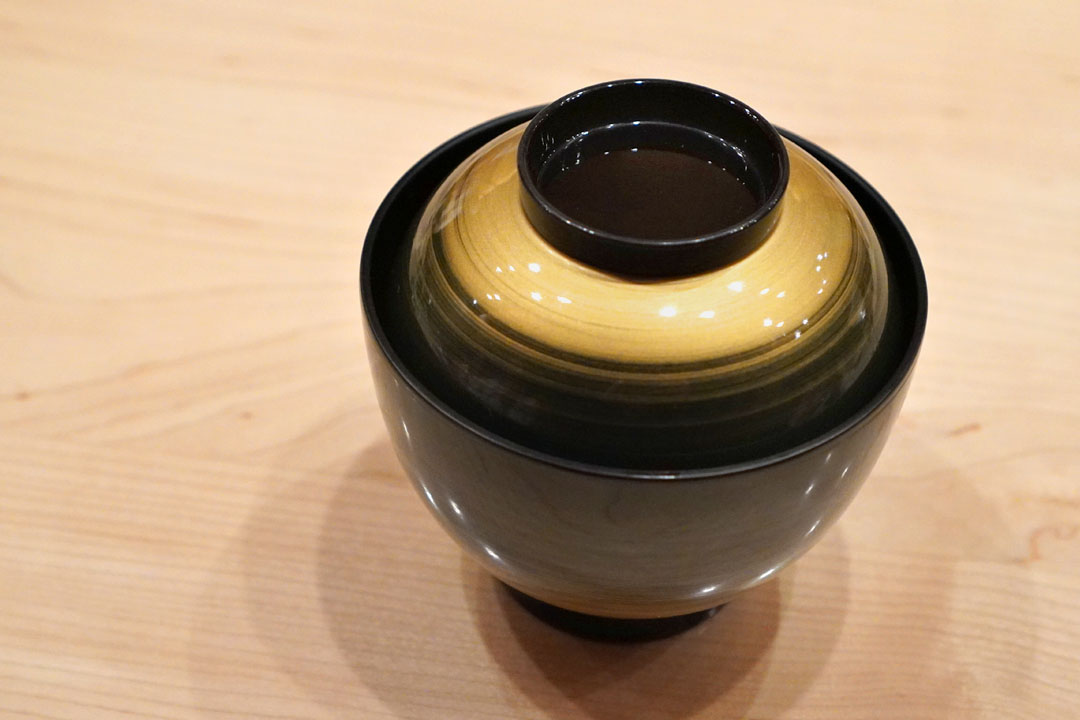

21: Suimono
A fish bone-enhanced clear soup was cozy and comforting, the broth's savoriness nicely accented by the incorporation of seaweed.

22: Tamagoyaki
Last was a twosome of castella-style tamago. I started with Kaneyoshi's on the right, which had a more "saturated" consistency along with a balance of tangy and umami flavors. On the other hand, Inaba's was noticeably sugarier, and actually recalled the frozen pound cakes of my childhood, but in a good way. Humorously, the Chefs commented that the two preparations of gyoku reflected their personalities.
It's not often that I enjoy a tag team sushi omakase meal, so this was a delightful change of pace. What stood out immediately was just the breadth of cuisine offered, as it's clear that the two Chefs aren't shy about stepping outside the bounds of strict nigiri. These so-called "cooked dishes" looked to me as more joint exercises, while on the other hand, the actual sushi was where the two more clearly differentiated themselves. The key really was the rice. Inoue-san's was essentially what one would typically expect, while Hirano-san's went heavier on the akasu, giving it a more aggressive acidity, while texturally, his grains were more assertive as well. Meanwhile, both men seemed to play with the temperature of their shari to boot. All in all, a memorable evening, one that made me think that more sushi chefs should give collaboration a whirl.
250 1st St, Los Angeles, CA 90012
213-277-2388
kaneyoshi.us
Tue 05/20/2025, 07:00p-10:25p
If I'm thinking about the top sushi-ya in Southern California, two of the names that come to mind are Yasuhiro Hirano's (平野泰洋) Sushi Inaba (鮨稲葉) in Torrance and Yoshiyuki Inoue's (井上嘉之) Sushi Kaneyoshi (鮨かね嘉) in Downtown. The two shokunin have actually know each other for quite a while, and first started working together in April 2020, crafting bara-chirashi boxes during the early days of the pandemic. The partnership lasted until the opening of Kaneyoshi for takeout in August that year, while on-site dining started there the following April. Although both Chefs were now running their restaurants full-time, they still wanted to be able to cook together, and thus this series of collaborative omakase dinners was instituted--Tuesdays at 7:00pm at Kaneyoshi, for up to a dozen diners each time, at a charge of $400 a head.

Decor-wise, things really haven't changed much at all since the subterranean restaurant opened (it's located in the basement of Little Tokyo's Kajima Building).

Here we see the view from my seat, the fifth position from the left.

Shown above is Sushi Kaneyoshi's sake list and selection of wines and other sundry beverages. If you'd like to bring your own booze, the corkage fee is $100 per bottle. Click for a larger version.

A straightforward place setting. Note that the oshibori was chilled (apropos given the hot weather), and was replaced ahead of the nigiri section of our dinner.

Chef Inoue and assistant Anton plating our first course.

1: Sawara Furai
The collab commenced with delicately-fried, panko-coated Japanese king mackerel, topped with a heady miso-based sauce teeming with familiar, savory-sweet flavors. I quite liked the brightness imparted by the shiso blossoms as well.

Inoue-san (left) and Hirano-san (right) preparing our next course.

We opted for sparkling junmai-shu (純米酒 発泡性) tonight and BYOB'd three bottles, starting with the 2023 Aramasa Private Lab Amagaeru Clear (新政 プライベートラボ 天蛙 クリア), a low-alcohol, pasteurized, secondary-fermented, 60% seimai-buai nihonshu crafted from Akita Prefecture rice. Released this year, the "tree frog" sake possessed aromas of sweet pâtisserie and tropical-leaning fruit, with a hint of heat underneath. On the palate, this demonstrated a light effervescence and elegant acidity, with familiar notes of lush orchard fruits rendered in a dry-ish manner. This was a great way to start, and just a lovely tipple in general.

2: Uni Soba
Chef Hirano regularly serves soba over at Sushi I-naba, so it was no surprise to see the dish featured tonight. The buckwheat noodles were great texturally, with a lovely chew, while their nuttiness made a lot of sense with all the savory, smoky, and sweetly saline flavors happening here. Nice zestiness from the hanaho, too.

Yoshiyuki-san and Yasuhiro-san readying our chawanmushi course.


3: Chawanmushi
The chawanmushi was unlike most I've had. What really struck me was the seaweed, which had this unabashedly grassy character that linked up quite well with the brininess of the shrimp. And at the same time, the egg custard itself was perked up by the sourness of what I believe was yuzu, all making for a more refreshing dish than I'm accustomed to.

4a: Kue Sashimi
Longtooth grouper is a relatively uncommon sight around these parts, so it was nice to see it on the menu. The kue showed off a satisfying, slightly chewy texture, while its clean, lean taste was beautifully complemented by a dab of salt, which seemed to really emphasize the fish's sweetness.

4b: Shako
Japanese mantis shrimp is another atypical item at local sushi restaurants, so once again, I was glad to enjoy it tonight, especially since we were right in the middle of the season. The shrimp had that almost "spongey" consistency I was expecting, while its savory, saline qualities were countered by both a layer of sweetness and the heat of wasabi.

Chef Yoshiyuki slicing cuts of bonito for the following course.

5: Katsuo Tataki
Seared skipjack tuna showcased a delectable, lingering smoke that married swimmingly with the roasty qualities of nori. Simultaneously, an egg-boosted soy sauce actually served to moderate the strong flavors at play.

6: Tsubugai
Whelk was a bit of an unexpected sight, but not an unwelcomed one. The sea snail had that chewy, almost "crunchy" texture I was looking for, while flavors were a familiar mix of savory and sweet.

7: Nodoguro
Given that it's a perennial favorite of mine, I was happy to find blackthroat seaperch on the menu this evening. I was certainly a fan of the fish's soft, fatty, flavorful flesh, tinged with a hint of char, as well as the grassy, oceany contribution from the seaweed on the back end. However, what surprised me was the akamutsu's "freshness" compared to most preparations I've had.

8: Hotaru Ika
Oil-marinated firefly squid conveyed a long-lingering brininess that was perfectly offset by the familiar zing of chopped onion and the prickliness of Japanese pepper.

Our second BYO selection was the 2023 Aramasa Private Lab Amagaeru Clear Dry (新政 プライベートラボ 天蛙 クリア ドライ), another low-alcohol sparkler made from Akita Sake Komachi (秋田酒こまち) rice and Kyokai No. 6 (きょうかい6号) yeast. This "celestial frog" was actually the companion bottle to the one above, and was designed to be markedly drier, I'm assuming the result of an extended fermentation process. The nose was less generous, though it still offered up that pastry-like sweetness, and this time with much clearer melon-like nuances. Taking a sip, I found this significantly fizzier, with much bigger bubbles that definitely perked up the palate in a crisp, sharp, almost brazen manner. This was also considerably drier, as its name would suggest, but there was still a backbone of fruitiness that kept things in balance. Overall, it was great to be able to compare these two sister sakes back-to-back.

9: Ankimo
A shard of monkfish liver had it savory, sweet, saline qualities well-accented by the sting of wasabi.

10: Uzaku
Grilled freshwater eel display an agreeable char along with an abundance of dark, savory flavors, all evened out by both cucumber and a vinegar dressing.

We knew that the sushi portion of our meal was about to begin once the ginger (a saltier than usual preparation) appeared.

11: Kinmedai
Golden eye snapper is one of my preferred neta, so it was nice to kick things off with it. The fish had the supple mouthfeel I was hoping for, while its sweetness was set off by the noticeable warmth of the shari.

12: Aori Ika
A well-scored cut of bigfin reef squid arrived soft and sticky, while its gently sweet taste went hand-in-hand with both the aggressively tangy rice and the nuttiness of that sesame seed topping.

Anton-san searing toro using Japanese charcoal.

13: Toro
Not surprisingly, the tuna belly was the most in-my-face nigiri of the night, its plethora of rich, fatty, smoky, umami-laden flavors duly tempered by that mild sumeshi.

14: Akami Zuke
Marinated tuna was smooth and silky in the mouth, the fish melding seamlessly with both soy and wasabi, all while that vinegar-forward rice kept things in check.

Yoshi-san and Yasu-san are shown assembling mushi zushi.

15: Gindara Mushi Sushi
A preparation of mushizushi (steamed sushi) featuring black cod was a first for me. I found the sablefish tender and flaky, its subdued salinity brightened up by pea and ginger while a thick sauce (ankake perhaps?) helped bind everything together.

The evening's final libation was the Aramasa Next Five The Final 2024, a 40% seimai-buai, kimoto-style, wood-aged sparkling junmai-daiginjo made with 100% Misato Nishiki (美郷錦) rice harvested in Akita Prefecture in 2022. Interestingly, this was actually a collaborative effort from five Akita-area sake brands: Aramasa (新政), Harukasumi (春霞), Ippakusuisei (一白水成), Yamamoto (山本), and Yukinobijin (ゆきの美人). The NEXT5 unit was formed back in 2010, and this was apparently their final creation together, bottled back in February last year. In any case, the bouquet here was fresh and invigorating, with a pastry dough-esque sweetness backed by a pert minerality that I didn't get in either of the preceding bottles. Palate-wise, this was pleasingly pétillant, with a thicker, richer mouthfeel and plenty of fruity, almost tropical flavors, all tinged with a bit of lactic goodness. Just delightful.

16: Aji
I always look forward to horse mackerel, and it was spot-on tonight. The fish highlighted a robust-yet-refined brininess that meshed like clockwork with both ginger and the countering qualities of the rice.

17: Mehikari Tempura
Mehikari (round greeneyes) is another ingredient I don't encounter too often, which is shame given how delicious it was. The fish had a pretty remarkable sweetness that combined perfectly with that flaked salt, all while both the tart rice and toasty seaweed completed the experience. A surprise standout for me.

18: Kohada
The gizzard shad was also a winner thanks to its gratifyingly meaty texture, healthy dosing of sweetness, and sophisticated salinity. Once again, the rice was crucial here for balance.

Chef Yasuhiro was using two brands of uni tonight: Sapporo Kaneshin Suisan (札幌 カネシン 水産) and Hokkaido Nemuro Maruichi Suisan (北海道 根室 マルイチ 水産).

19: Bafun Uni
The sea urchin above was served two ways. I started with the presentation on the right, which was composed of both female and male roe. It had all the cool, sweet-n-saline qualities I anticipated, and combined impeccably with the Chef's warm, piquant rice. On the left were exclusively male gonads, which I'd say were more umami-forward, with this nuttiness that really came through.

20: Anago
Saltwater eel ate soft and sweet, its pinpricks of salinity regulated by that sticky-ish, gently-seasoned rice.


21: Suimono
A fish bone-enhanced clear soup was cozy and comforting, the broth's savoriness nicely accented by the incorporation of seaweed.

22: Tamagoyaki
Last was a twosome of castella-style tamago. I started with Kaneyoshi's on the right, which had a more "saturated" consistency along with a balance of tangy and umami flavors. On the other hand, Inaba's was noticeably sugarier, and actually recalled the frozen pound cakes of my childhood, but in a good way. Humorously, the Chefs commented that the two preparations of gyoku reflected their personalities.
It's not often that I enjoy a tag team sushi omakase meal, so this was a delightful change of pace. What stood out immediately was just the breadth of cuisine offered, as it's clear that the two Chefs aren't shy about stepping outside the bounds of strict nigiri. These so-called "cooked dishes" looked to me as more joint exercises, while on the other hand, the actual sushi was where the two more clearly differentiated themselves. The key really was the rice. Inoue-san's was essentially what one would typically expect, while Hirano-san's went heavier on the akasu, giving it a more aggressive acidity, while texturally, his grains were more assertive as well. Meanwhile, both men seemed to play with the temperature of their shari to boot. All in all, a memorable evening, one that made me think that more sushi chefs should give collaboration a whirl.
2 Comments:
Would really appreciate to hear how are you able to procure such special bottles of Aramasa? V cool post!
One of my dining companions procured them from a source in Japan. ;)
Post a Comment
Subscribe to Post Comments [Atom]
<< Home